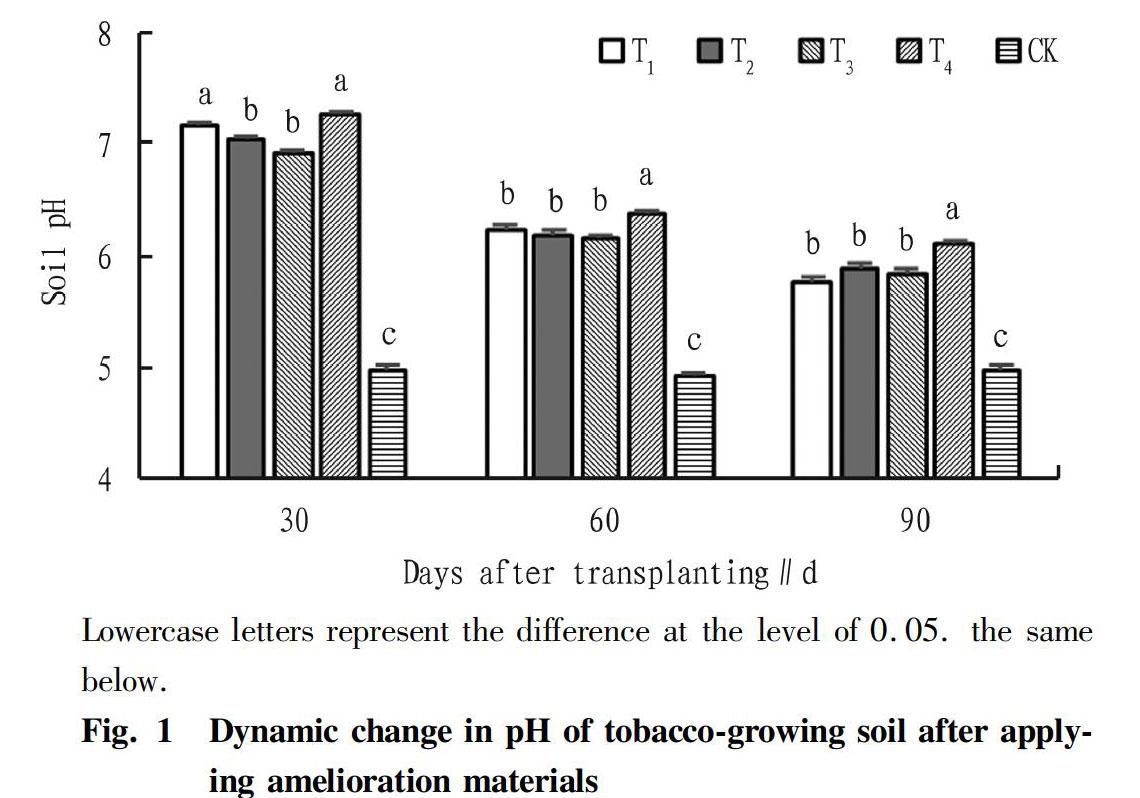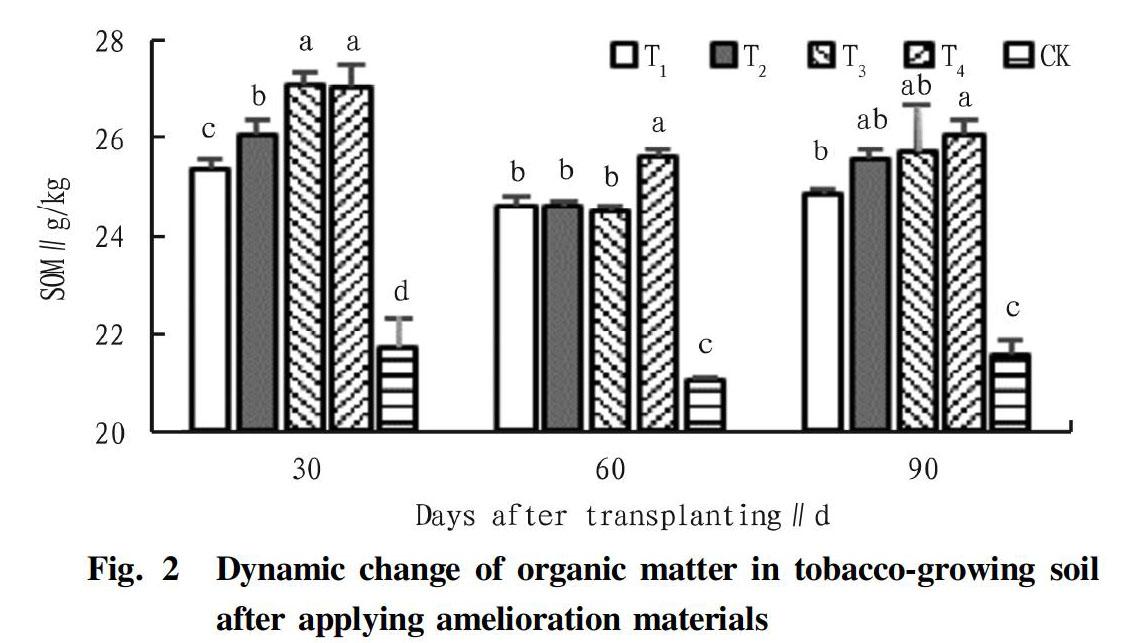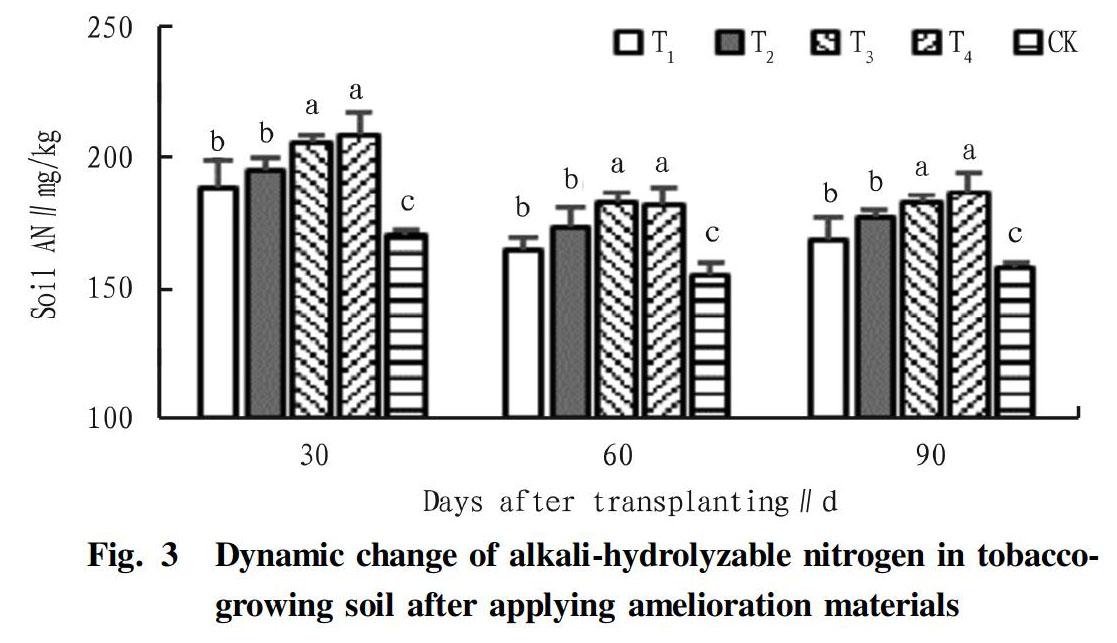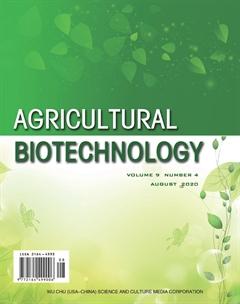Dynamic Changes of Tobacco-growing Soil Nutrients and Enzymes After Application of Amelioration Materials
Zhanghong CAO Gexuan SU Yongjun LIU Shuguang PENG Yongsheng DENG Jin CHEN Deyuan PENG Zhenghua WANG Jingjing WU Qianping YAN Xiaohua DENG



Abstract [Objectives] This study was conducted to clarify the improvement effects of different soil amelioration materials such as lime, green manure and bio-organic fertilizer on acidic tobacco-planting soil.
[Methods] The dynamic changes of soil pH, soil nutrients and enzyme activity were studied by applying lime, lime+green fertilizer, and lime+green fertilizer+biological organic fertilizer.
[Results] ① After the application of amelioration materials, the soil pH and available phosphorus content of tobacco-growing soil showed a stepwise change of first increasing and then decreasing, and became stable at 60 d after tobacco transplanting; the soil organic matter, alkali-hydrolyzable nitrogen and available potassium content showed a gradual change trend of "high-low-high"; and the soil invertase and urease activity showed a gradual change trend of "low-high-low". ② To 90 d after tobacco transplanting, the application of amelioration materials increased soil pH by 1.29-1.62 units, and increased organic matter content by 15.21%-20.86%, alkali-hydrolyzable nitrogen content by 6.83%-18.17%, available phosphorus content by 54.15%-217.85%, rapidly available potassium content by 11.42%-30.86%, soil invertase activity by 70.09%-18.93%, and soil urease activity by 64.07%-130.47%. ③ The combination of lime+green manure+alkaline microbial organic fertilizer had the best effect on the improvement of acidic tobacco-growing soil, and the effect of lime+green manure+acid microbial organic fertilizer on acidic soil was the second.
[Conclusions] When applying lime, green fertilizer and alkaline bio-organic fertilizer should be applied to achieve sustainable improvement of strongly acidic soil.
Key words Amelioration materials; Soil pH; Main nutrients of tobacco-growing soil; Soil enzymes
A good soil environment is a necessary condition for flue-cured tobacco cultivation[1-2]. Acidic soil will activate heavy metal ions in the soil[3], affect the decomposition of soil organic matter, and reduce soils ability to retain fertilizer[4], thereby affecting the growth of flue-cured tobacco and the increase in yield, quality and efficiency[5]. Improving and restoring acidic tobacco-growing soil to create a good soil environment for the growth of flue-cured tobacco has become an important measure to improve the efficiency of flue-cured tobacco production[6]. Single application of lime to increase soil pH is a commonly used method[7], and its cost is also low, but long-term and large amounts of single application of lime will also cause soil compaction and the decrease in availability of soil nutrients such as potassium and magnesium[4,8]. The combined application of lime and organic improver[9-11] can not only increase soil pH, but also increase soil fertility, and has become the development trend of acid soil improvement. There have been many research reports on the application of lime to increase the pH of tobacco-growing soil[3,12], the improvement of acidic soil by lime combined with green manure[9,13], and the synergistic remediation of acidic soil by lime and green manure and microbes[14] to improve the quality of tobacco leaves and planting benefits, but few studies have been conducted on the effects of combined application of lime+green manure+microbial organic fertilizer on tobacco plant nutrients and soil enzymes. Based on this, the pot planting method was used to study the dynamic changes of nutrients and enzymes in tobacco-growing soil after comprehensive improvement of acidic soil with lime, green manure and microbial organic fertilizer, aiming to provide a reference for the conservation of tobacco-growing soil in mountains.
Materials and Methods
Experimental materials
The experiment was conducted in Gaofeng Town, Cili County, Hunan Province in 2019 (29.44°N, 110.92°E). The flue-cured tobacco variety was Yunyan 87. The potted test soil was yellow-brown loam, which had a soil pH of 5.04 and contained organic matter 19.42 g/kg, alkali-hydrolyzale nitrogen 90.45 mg/kg, available phosphorus 7.21 mg/kg, and rapidly available potassium 123.55 mg/kg. Lime was slaked lime purchased on the market, and its application rate was 2 250 kg/hm2. The green manure was fresh oat grass, cut into 10 cm segments, and the application amount was 7 500 kg/hm2. The acidic biological organic fertilizer was a commercial fertilizer, pH=6, N+P2O5+K2O≥8%, organic matter content≥45%, living bacteria count≥50 million/g, and the application rate was 450 kg/hm2. The alkaline biological organic fertilizer was Mongolian sheep farmyard manure+compound probiotics, pH=8, N+P2O5+K2O≥5%, organic matter content ≥45%, living bacteria count≥0.2 billion/g, and the application rate was 450 kg/hm2.
Experimental design
The experiment was designed with 5 treatments, namely T1: lime, T2: lime+green manure, T3: lime+green manure+acidic bio-organic fertilizer, T4: lime+green manure+alkaline bio-organic fertilizer, and control check (CK), without applying amelioration materials. The application amounts of lime, green manure and organic fertilizer referred to previous studies[3,14]. The nitrogen, phosphorus and potassium fertilizing amounts of all treatments were the same. Each pot was applied with 13 g of lime, 87 g of green manure, 25 g of acidic bio-organic fertilizer, and 45 g of base fertilizer special for tobacco. The test soil was uniformly mixed with lime, green manure, bio-organic fertilizers and other base fertilizers thoroughly. Plastic pots, that had a height of 26 cm, an upper mouth width of 40 cm and a lower mouth width of 20 cm, were added with 13 kg of the soil, respectively, and nylon cloth with a pore size of 48 μm was placed at the bottom. Then, the plastic pots were buried into the soil, followed by ridging, with the pot mouth flush with the ridge surface. Each treatment was done in three repetitions, each of which was planted with 10 tobacco plants. The planting density of flue-cured tobacco was 16 650 plants/hm2 (1.2 m×0.5 m), and protection lines were set around. Other cultivation management measures were the same as high-quality flue-cured tobacco production technical regulations in Zhangjiajie.
Main testing indicators and methods
At 30, 60 and 90 d after transplanting of flue-cured tobacco, 3 pots were selected from each treatment, and 3 points were selected in each pot to collect the soil with a thickness of 0-15 cm, to form a mixed soil sample. The soil pH was determined by the potentiometric method[15]; soil organic matter (SOM), alkali-hydrolyzale nitrogen (AN), rapidly available phosphorus (AP), and rapidly available potassium (AK) were determined by potassium dichromate volumetric method, alkaline hydrolysis diffusion method, sodium bicarbonate leaching-molybdenum antimony colorimetry and ammonium acetate leaching-flame spectrometry, respectively[15]; and soil invertase and urease activity were determined by Na2S2O3 titration method and indophenol blue colorimetry, respectively[15].
Statistical analysis methods
Microsoft Excel 2003 and SPSS17.0 were adopted for data processing and statistical analysis. Duncan method was used to test the significance at the level of P=0.05.
Results and Analysis
Dynamic change of soil pH in tobacco planting
From Fig. 1, with the development of flue-cured tobacco growth, the pH of different treatments showed a decreasing trend. Thirty days after transplanting, the soil pH of T1, T2, T3, and T4 increased from the soil background value of 5.04, respectively, to 7.17, 7.03, 6.92, and 7.26, which increased by 2.13, 1.99, 1.88, and 2.22 units, respectively. Ninety days after transplanting, the soil pH of T1, T2, T3, and T4 decreased, respectively, to 5.77, 5.88, 5.83, and 6.10, which increased by 1.40, 1.15, 1.09, and 1.16 units, respectively, compared with 30 d, and by 0.47, 0.30, 0.32, and 0.27 unit, respectively, compared with 60 d. During this period, the pH of the soil in the CK varied between 4.93 and 4.98, slightly lower than the soil background value. The soil pH values of T1, T2, T3, and T4 were all significantly higher than that of the CK from 30 to 90 d after transplanting of flue-cured tobacco; at 30 d after transplanting, the differences of T1 and T4 from T2, T3 and the CK were significant, and the soil pH of T1 decreased significantly afterwards; and at 90 d after transplanting, the soil pH of T4 was significantly higher than that of other treatments, and there were no significant differences between T1, T2, and T3. It could be seen that after applying the amelioration materials, the soil pH firstly increased and then decreased, and was stabilized at 60 d after transplanting of flue-cured tobacco. The effects of applying different amelioration materials to increase the pH of the acid soil were different, and T4 (lime+green manure+alkaline bioorganic fertilizer) achieved the best effect.
Dynamic change of organic matter in tobacco-growing soil
From Fig. 2, the organic matter contents of different treatments showed a change trend of "high (30 d)-low (60 d)-high (90 d)". Thirty days after transplanting, the soil organic matter contents of T1, T2, T3, and T4 increased from the background value of 19.42 g/kg, respectively, to 25.39, 26.07, 27.1, and 27.07 g/kg, which increased by 30.74%, 34.24%, 39.55% and 39.39%, respectively. Sixty days after transplanting, the soil organic matter content decreased slightly. To 90 d after transplanting, the soil organic matter contents of T1, T2, T3 and T4 increased, respectively, to 24.85, 25.57, 25.74 and 26.07 g/kg, which decreased by 2.13%, 1.92%, 5.02% and 3.69%, respectively, compared with 30 d. During this period, the organic matter content of the soil in the CK varied between 21.03 and 21.71 g/kg, slightly higher than the soil background value. The organic matter contents of T1, T2, T3, and T4 were always significantly higher than that of the CK during 30-90 d after transplanting. Among the treatments of different amelioration materials, the organic matter contents of T3 and T4 were significantly higher than those of T1 and T2 at 30 d after transplanting; the organic matter content of T4 was significantly higher than those of T1, T2 and T3 at 60 d after transplanting; and at 90 d after transplanting, the organic matter content of T4 was significantly higher than that of T1. It could be seen that the application of different amelioration materials affected the content of soil organic matter, and T4 (lime+green manure+alkaline biological organic fertilizer) had the best effect on improving soil organic matter.
Dynamic change of alkali-hydrolyzable nitrogen in tobacco-growing soil
From Fig. 3, the contents of alkali-hydrolyzable nitrogen in the soil of different treatments showed a trend of "high (30 d)-low (60 d)-high (90 d)". Thirty days after transplanting, the values of T1, T2, T3, and T4 increased from the background value of 90.45 mg/kg, respectively, to 188.05, 194.88, 205.62, and 208.35 mg/kg, which increased by 107.90%, 115.46%, 127.33%, and 130.35%, respectively, which might be related to the application of nitrogen fertilizer in the early stage of flue-cured tobacco. Afterwards, the soil alkali-hydrolyzable nitrogen decreased, and at 90 d after transplanting, the soil alkali-hydrolyzable nitrogen content decreased by 10.60%, 9.12%, 11.33%, and 10.75% compared with 30 d after transplanting. During this period, the soil alkali-hydrolyzable nitrogen content of the CK was in the range of 154.65-169.73 mg/kg, which was higher than the soil background value. During 30-90 d after transplanting, the soil alkali-hydrolyzable nitrogen contents of T1, T2, T3, and T4 were significantly higher than the CK, and T3 and T4 had significant differences from T1 and T2. At 90 d after transplanting, T1, T2, T3, and T4 were 6.83%, 12.54%, 15.85%, and 18.17% higher than the CK, respectively. It could be seen that the application of different amelioration materials could increase the content of soil alkali-hydrolyzable nitrogen, and T3 and T4 (lime+green manure+biological organic fertilizer) had the best effect.
Zhanghong CAO et al. Dynamic Changes of Tobacco-growing Soil Nutrients and Enzymes After Application of Amelioration Materials
Dynamic change of available phosphorus in tobacco-growing soil
From Fig. 4, the soil available phosphorus contents of different treatments showed a downward trend overall. At 30 d after transplanting, the available phosphorus contents in the soil of T1, T2, T3, and T4 increased from the background value of 7.21 mg/kg, respectively, to 37.18, 47.87, 59.12, and 64.84 mg/kg, which increased by 415.67%, 563.94%, 719.97%, and 799.31%, respectively. The values gradually decreased then, and to 90 d after transplanting, the soil available phosphorus contents of T1, T2, T3, and T4 decreased by 46.10%, 36.64%, 31.90%, and 36.27% compared with the soil available phosphorus contents at 30 d after transplanting, respectively. However, the available phosphorus content of the CK soil during this period varied from 13.00 to 24.93 mg/kg, which was higher than the soil background value. The soil available phosphorus contents of T1, T2, T3, and T4 were significantly higher than that of the CK from 30 to 120 d after transplanting of flue-cured tobacco, and the available phosphorus content of T4 was significantly higher than those of T1 and T2. The available phosphorus content of T4 was significantly higher than T3 in the period of 30-60 d after transplanting. At 90 d, there was no significant difference in the available phosphorus content between T3 and T4; and the available phosphorus contents of T1, T2, T3 and T4 were 54.15%, 133.31%, 209.69% and 217.85% higher than the CK, respectively. It could be seen that different amelioration materials had different effects on increasing the available phosphorus content of the soil, and T4 (lime+green manure+alkaline bio-organic fertilizer) had the best effect, followed by T3 (lime+green manure+acid bio-organic fertilizer).
Dynamic change of available potassium content in tobacco-growing soil
From Fig. 5, the available potassium contents of different treatments showed a "high (30 d)-low (60 d)-high (90 d)" trend. Thirty days after transplanting of flue-cured tobacco, the soil available potassium contents of T1, T2, T3, and T4 increased from the background value of 123.55 mg/kg, respectively, to 266.43, 313.38, 328.13, and 478.71 mg/kg, which increased by 115.65%, 153.65%, 165.58%, and 287.46% respectively. The values gradually decreased then, and to 90 d after transplanting, the soil available potassium contents of T1, T2, T3 and T4 decreased by 21.4%, 26%, 25.04% and 48.83% compared with the soil available potassium contents at 30 d after transplanting. However, soil available potassium content of the CK during this period varied from 178.24 to 256.37 mg/kg, which was higher than the soil background value. At 30-60 d after transplanting, the soil available potassium content of T4 was significantly higher than those of T1, T2, T3, and the CK, while the available potassium content of T3 at 90 d after transplanting was not significantly different from that of T4. The soil available potassium contents of T1, T2, T3 and T4 were 11.42%, 23.37%, 30.86% and 30.33% higher than the CK at 90 d after transplanting. It could be seen that the application of suitable amelioration materials could increase the soil available potassium content, and T4 (lime+green manure+alkaline bio-organic fertilizer) had the best effect, followed by T3 (lime+green manure+acid bio-organic fertilizer).
Effect on soil invertase
From Fig. 6, the soil invertase activity of different treatments showed a "low (30 d)-high (60 d)-low (90 d)" trend. At 30 d after transplanting, the activity of soil invertase ranked as T3>T4>T2>T1>CK, and the activity of soil invertase in T1, T2, T3, and T4 was significantly higher than that of the CK, 26.64%, 32.56%, 53.65% and 41.07% higher than the CK, respectively; and the soil invertase activity in T3 and T4 was significantly higher than that in T1 and T2. At 60 d after transplanting, the soil invertase activity ranked as T4>T3>T2>T1>CK, and the soil invertase activity in T1, T2, T3, and T4 was significantly higher than the CK; and the soil invertase activity in T3 and T4 was significantly higher than that in T1 and T2. At 90 d after transplanting, the activity of soil invertase ranked as T3>T4>T2>T1>CK, and the activity of soil invertase in T1, T2, T3, and T4 was significantly higher than that in the CK, and was 70.09%, 81.19%, 118.93%, and 108.78% higher than the CK, respectively; and the soil invertase activity in T3 and T4 was significantly higher than that in T1 and T2. It could be seen that the application of different amenlioration materials would increase the activity of soil invertase, and T3 and T4 (lime+green manure+biological organic fertilizer) had the best effect.
Effect on soil urease
From Fig. 7, the soil urease activity of different treatments showed a "low (30 d)-high (60 d)-low (90 d)" trend. At 30 d after transplanting, the soil urease activity ranked as T4>T3>T2>T1>CK, and the differences between the different treatments were significant. The soil urease activity of T1, T2, T3, and T4 increased by 10.58%, 34.62%, 53.85%, and 83.65% compared with the CK, respectively. At 60 d after transplanting, the soil urease activity ranked as T4>T2>T3>T1>CK, and the soil urease activity in T1, T2, T3, and T4 was significantly higher than that in the CK; and the soil urease activity of T4 was significantly higher than that of T1, T2, and T3. At 90 d after transplanting, the soil urease activity ranked as T4>T3>T2>T1>CK, and the soil urease activity of T1, T2, T3, and T4 was significantly higher than that of the CK, 64.06%, 104.69%, 105.47%, and 130.47% higher than the CK, respectively; and the soil urease activity of T4 was significantly higher than T1, T2, and T3. It could be seen that the application of different amelioration materials could improve the soil urease activity, and T4 (lime+green fertilizer+alkaline biological organic fertilizer) had the best effect.
Discussion and Conclusions
The application of amelioration materials to control soil acidification, restore soil fertility, and increase soil productivity is an indispensable agricultural measure for sustainable agricultural development. Acidified soil not only has low soil pH, but also is accompanied by degradation of soil fertility[4]. Therefore, the acidity improvement of acid soil must be synchronized with fertilization to achieve the purpose of soil acidification control and remediation. Lime application can increase soil pH to a certain extent and alleviate soil acidification[15]. The application of organic materials can increase soil nutrient content in tobacco fields[16], and increase urease activity[17]. Lime, green manure and bio-organic fertilizer and other multi-material combinations can show good complementarity and improve the acid soil improvement effect[18]. These conclusions are consistent with the results of this study.
In experiments, although the single application of lime can quickly increase the soil pH, the soil pH will also drop rapidly due to the buffering effect and self-adjusting ability of the soil. Although the combined application of lime and green manure could not increase the soil pH as high as lime alone, the soil pH declines more slowly, especially with the integrated use of lime, green manure and microbial organic fertilizer, the decrease of soil pH is not only slow, but also small. The main reason is that returning green manure to the field can increase soil organic matter content, which is beneficial to increase the soils buffer capacity of acid and alkali; and microbial organic fertilizer will increase soil microbial diversity, accelerate the decomposition of crop residues, and have an important impact on improving soil organic matter. Therefore, while applying lime to remediate acidic soil, combined with green manure returning to the field and bio-organic fertilizer, the effects of inorganic fertilizer, organic fertilizer and microbes can be superimposed, which can stabilize the effect of lime on acid soil, and the acid improvement is synchronized with fertilization to maximize fertilizer efficiency and improve economic efficiency.
The results of this study showed that the soil pH, soil organic matter, soil alkali-hydrolyzable nitrogen, available phosphorus, rapidly available potassium, soil invertase activity, and soil urease activity showed phased changes in acid soil after applying soil improvement materials. The application of amelioration materials could increase soil pH, organic matter, alkali-hydrolyzable nitrogen, available phosphorus, rapidly available potassium contents, and soil invertase and urease activity. Among different treatments, "lime+green manure+alkaline microbial organic fertilizer" exhibited the best effect on improving acid soil.
References
[1] CAO ZH. Soil and fertilization for high-quality flue-cured tobacco production[M]. Nanjing: Jiangsu Science and Technology Press, 1991. (in Chinese)
[2] DENG XH, ZHOU ML, TIAN F, et al. Theory and practice of maintenance and improvement of mountain tobacco planting soil[M]. Beijing: China Agricultural Science and Technology Press, 2019. (in Chinese)
[3] XUN HF. Study on the influence of different soil amendments on the chemical properties of acid soil[D]. Danzhou: Hainan University, 2004. (in Chinese)
[4] XU RK, LI JY, ZHOU SW, et al. Scientific problems and technical measures of farmland soil acidification control in China[J]. Bulletin of Chinese Academy of Sciences, 2018, 33(2): 160-167. (in Chinese)
[5] DENG XH, ZHANG LH, CHEN J, et al. Effects of modifiers on the physical and chemical properties of acid soil and the growth and quality of flue-cured tobacco[J]. Chinese Tobacco Science, 2018, 39(6): 14-20. (in Chinese)
[6] CHEN J, DENG HH, LI YH, et al. Strong acidic conditions impaired photosynthesis, root system and seedling growth of flue-cured tobacco[J]. International Journal of Agriculture & Biology, 2020, 24(3): 645-650.
[7] ZHANG Y, DENG XH, YANG LL, et al. Effects of different amendments application on remediation of acidic soil[J]. Journal of Soil and Water Conservation, 2018, 32(5): 330-334. (in Chinese)
[8] LI YH, DENG XH, ZHANG ZW, et al. Acid-alkali buffering characteristics and affecting factors of typical tobacco planting soils in western Hunan[J]. Chinese Journal of Eco-Agriculture, 2019, 27(1): 109-118. (in Chinese)
[9] LI YH, LI YH, DENG XH, et al. Effects of application of lime and green manure on acid soil improvement in different cropping systems[J]. Journal of Soil and Water Conservation, 2018, 32(6): 367-372. (in Chinese)
[10] XING SH, XIONG DZ, ZHOU BQ, et al. Effects of different soil amendments on soil biochemical properties and yield of flue-cured tobacco[J]. Chinese Journal of Soil Science,2005(1): 73-75. (in Chinese)
[11] ZHU KY, SUN X, CHENG S, et al. Effects of different soil amendments on south Anhui tobacco-growing soil and flue-cured tobacco yield and quality[J]. Soils, 2016, 48(4): 720-725. (in Chinese)
[12] HU M, XIANG YS, LU JW. Effects of lime application rates on soil pH and available nutrient content in acidic soils[J]. Soil and Fertilizer Sciences in China, 2017(4): 72-77. (in Chinese)
[13] LI Y, LIU GD, ZHANG RL, et al. Dynamic effect on latosol pH value after leguminous green manure application and relevant mechanism[J]. Soils, 2012, 44(1): 101-106. (in Chinese)
[14] DENG XH, HUANG J, YANG LL, et al. The synergistic effect of lime, green manure and bio-organic fertilizer on restoration of acid field and improvement of tobacco production efficiency[J]. Journal of Plant Nutrition and Fertilizer, 2019, 25(9): 1577-1587. (in Chinese)
[15] BAO SD. Soil agrochemical analysis[M]. Beijing: China Agriculture Press, 2000.
[16] ZHANG MM, WANG BR, LI DC, et al. Effects of long-term N fertilizer application and liming on nitrification and ammonia oxidizers in acidic soils[J]. Acta Ecologica Sinica, 2015, 35(19): 6362-6370. (in Chinese)
[17] JIA W, ZHOU HP, XIE WY, et al. Effects of long-term returning corn stalks to the field combined with applying fertilizer in autumn on microbial biomass C, N and enzyme activity in cinnamon soil[J]. Acta Agriculturae Boreali-Sinica, 2008, 23(2): 138-142. (in Chinese)
[18] ZHANG LH, LI YH, DENG XH, et al. Dynamic changes of acid soil pH and physicochemical properties after application of lime and green manure and bio-organic fertilizer[J]. Acta Tabacaria Sinica, 2019, 25(3): 60-66.
- 农业生物技术(英文版)的其它文章
- Investigation on Agronomic Characters of Dwarf Mutant 778 in Broomcorn Millet (Panicum miliaceum L.) and Analysis of Its Sensitivity to GA
- Construction of Technology System on Development and Repropagation in Vitro of Several Cultivars in Pear
- Construction of Camellia oleifera Cultivation Standardization System
- Nutrients Determination in Nuts from Different Torreya grandis Cultivars
- Photosynthetic Physiological Response to Drought Stress of Populus euphratica at Different Ages in Minqin
- Effects of UV-B Radiation on the Activity of Antioxidants in Flue-cured Tobacco Leaves

